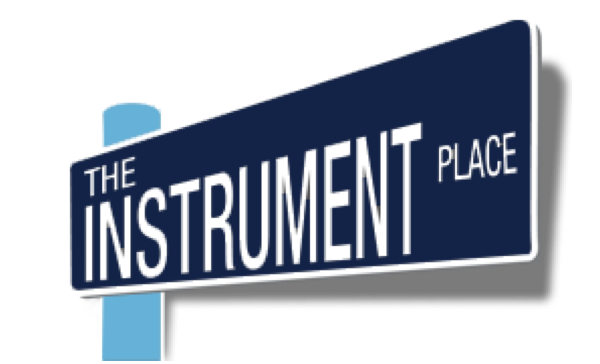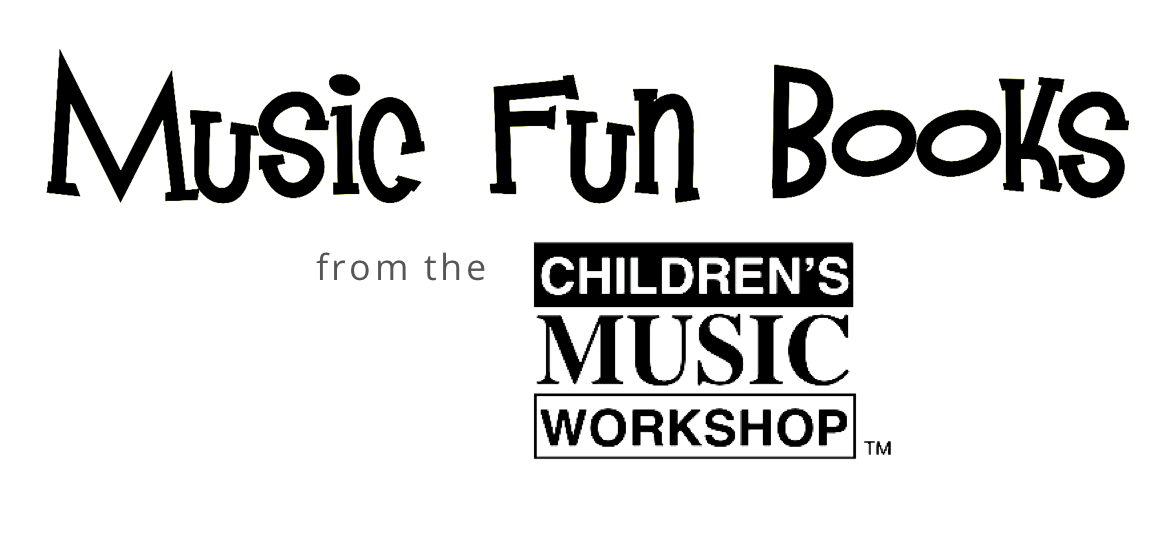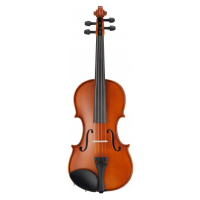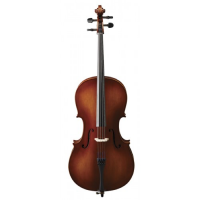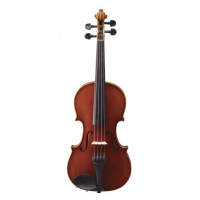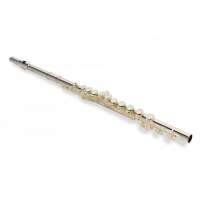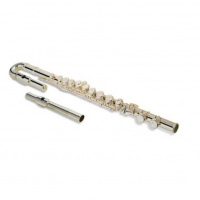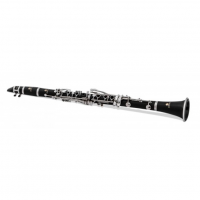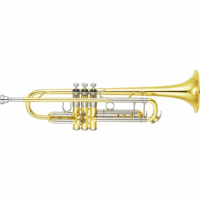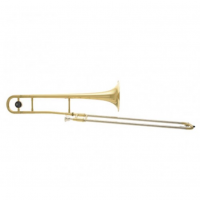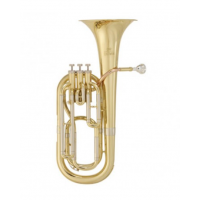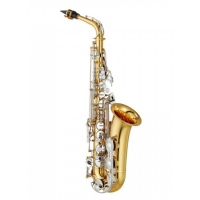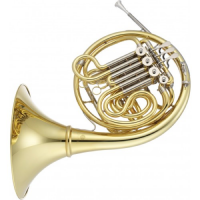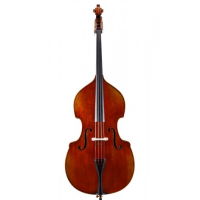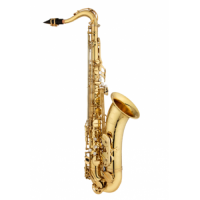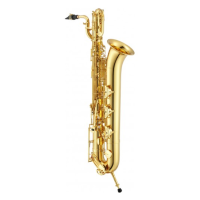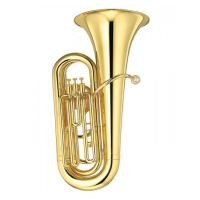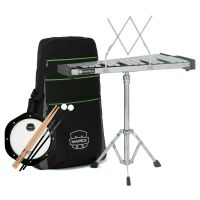Anatomy of the Trombone
Trombones are lower register brass instruments with over 2 meters of tubing that can produce some of the lowest tones heard in a jazz band and orchestra. While the traditional slide version of the trombone is a familiar sight, valved versions of the trombone with three valves are also quite popular.
The baritone horn is sometimes substituted for the trombone in an orchestra when using a trombone is impractical for some reason.
To be the best you can be at playing the trombone, you should know all of the usual names of the parts of the trombone and what function they perform. You should also know how individual trombone parts can be removed and replaced, how trombone parts should be serviced and maintained and what to do if you think a part of your student trombone horn is damaged or broken.
Let's learn about the anatomy of a typical trombone from end to end. If you'd like to jump ahead, use the anatomy chart above to click a part you'd like to read about first.
WHAT IS THE BELL?
The bell is where sound waves emerge from the trombone.
The bell of a trombone is highly polished and widely flared to spread the sound waves. The sound of the trombone, produced from the lips of the player and shaped through the horn, emerges at the bell with remarkable volume and a unique tone.
Care must be taken never to set your trombone on the floor or to leave it balanced on the edge of a table on its horn. This is true even on a carpeted surface. The polished surface scratches surprisingly easily and a horn on the floor is a recipe for an accident and a bent horn. The horn has been meticulously designed to produce the best tone and volume, so even a slight change in the shape of the metal can affect the sound. Store the trombone safely in its case when it is not in your hands or place it on an instrument stand designed specifically for trombones.
When you use your horn a lot, the bell and all the metal of the instrument can collect dirt, dust and fingerprints. Be sure to remove any dirt from the instrument immediately after each playing session, as it can very quickly degrade the finish of the instrument if left there. Polish gently with a soft lint-free cloth to remove any grime.
Click to return to anatomy chart
WHAT IS THE BRACE/ STRUT?
The slide braces or struts run horizontally between different sections of tubing to hold the trombone together securely.
The trombone is made out of thin tubing that doubles back on itself, so the struts help keep the whole instrument rigid to improve its resonance. On slide trombones, the braces on the slide portion of the tubing are known as slide braces.
Click to return to anatomy chart
WHAT IS THE BUMPER?
The bumper is a small rubber piece that protects the end of the trombone from impacting other things as it is played.
With an instrument as long as the trombone, it is possible that the player will contact other things as the trombone is carried or played. While the bumper can help reduce the impact of such a collision, the best defense against a damaged horn is vigilance and common sense. When playing, stay aware of the objects and people around you, especially if anyone is moving nearby.
Click to return to anatomy chart
WHAT IS THE COUNTERWEIGHT?
The counterweight helps the player balance the instrument as it is being played.
The counterweight is a small hockey-puck or bar-shaped device that fastens onto the brace located furthest behind the player. Because of the sizable length of the trombone, its front end can get heavy and require a measure of strength to hold up consistently while playing. In fact, it can be uncomfortable to hold and play for long periods unless the counterweight is attached.
Players differ in their opinions about whether or not the counterweight should be used, with some extolling the virtues of an easier playing experience while others say that the weight isn't necessary. The need for it can certainly be more or less apparent depending on the age, make and type of trombone. However, in general it tends to focus and darken the sound slightly as the instrument reacts to the additional mass the counterweight provides.
Click to return to anatomy chart
WHAT IS THE MOUTHPIECE?
The trombone's mouthpiece directs air and lip vibrations from the player into the body of the instrument.
The trombone mouthpiece is large and deep, and for this reason many players find the trombone to be one of the easiest brass instruments to produce a tone on even as a beginner.
Click to return to anatomy chart
WHAT IS THE MOUTHPIECE RECEIVER?
The mouthpiece receiver connects the mouthpiece to the trombone.
The mouthpiece receiver is a small metal cylinder fused to the end of the leadpipe that connects the mouthpiece to the trombone. Before playing, the mouthpiece is gently pressed into the receiver. It is a good idea to give the mouthpiece a small turn to tighten it slightly, but not too much. After playing, it is taken out for cleaning and storage.
Be sure not to apply too much pressure when placing the mouthpiece into the trombone's mouthpiece receiver, as the mouthpiece could get stuck or damage the receiver. Never strike the mouthpiece with your hand to tighten it, or you might have a stuck mouthpiece on your hands. If your mouthpiece gets stuck, do not try to remove it yourself. Take the trombone to your teacher or bring it in for repair.
Click to return to anatomy chart
WHAT IS THE TUBING?
The trombone has both cylindrical and conical bore sections carrying the sound waves from mouthpiece to bell.
The trombone's tubing is generally made of brass and would measure over 2 meters if laid end to end.
Sound waves originate from the mouthpiece, which is placed into the mouthpiece receiver. The player's lip vibration and flow of air vibrates inside the tubing to produce varying tones. The player's lips (in the mouthpiece) and fingers (depressing the valve pistons) work in combination to play each tone. The tubing ends with a flared bell.
Mutes can be used with a trombone bell to change the overall sound. True to their name, these devices mostly remove volume and certain frequencies as the sound waves pass over them, changing the timbre of the instrument. Most often, they are held in place just by cork grips.
Care must be taken never to set your trombone on the floor or to leave it balanced on the edge of a table on its horn. The horn has been meticulously designed to produce the best tone and volume, so even a slight change in the shape of the metal can affect the sound. Store the trombone safely in its case when it is not in your hands!
Click to return to anatomy chart
WHAT IS THE TUNING SLIDE?
The tuning slide is used to make micro-tuning adjustments to the trombone.
The tuning slide is found on the heel of the trombone and can be moved in and out with a small amount of pressure, allowing the player to make micro adjustments to the tuning as needed on the fly. This slide should be lubricated occasionally with a small amount of slide grease.
Care should be taken to ensure the tuning slide doesn't impact items and people around it while in playing position. Because the slide is located behind the sight line of the player, it is good practice to do a visual check behind you before lifting the trombone to play and glance occasionally over the shoulder to be sure nothing has come into possible collision distance without your knowledge.
Click to return to anatomy chart
WHAT ARE THE VALVE CASINGS?
The valve casings are cylindrical metal tubes that hold the pistons as they move up and down.
As the player depresses a valve piston on the trombone, it slides down in the casing to match up the holes in the casing that lead to different slides. The changes to the total tubing length that the air and sound waves pass through via these holes creates the different notes of the chromatic scale.
The valve casings can be lightly lubricated with a very thin coat of valve oil. Be careful not to over-oil your valve casings, or you will have a bit of a mess on your hands as it drains out the end of the casing.
Click to return to anatomy chart
WHAT ARE THE VALVE PISTONS?
The valve pistons move up and down inside the casings, changing the length of the tubing and the tone that is produced.
The player uses the fingers to depress the valve pistons in various patterns, which changes the air path inside the trombone slightly to produce a different tone. Each piston has holes that pierce through it, so as the piston slides down inside the casing the flow of air is changed. While each piston has only an official up and down position, some players have experimented with depressing the pistons only part way to produce different sound effects and notes from the instrument.
As far as pitch change, the valve pistons perform the same tasks as other valved instruments. The first valve lowers the tone one step, the second lowers it one half step, and the third lowers the pitch 1 and one half steps.
The valve pistons can be cleaned with a soft, lint-free cloth and lightly treated with valve oil to keep them functioning in top shape. Be sure to inspect them regularly to avoid having grit scratch the piston.
Note that if you remove a piston from a casing it is imperative to place each piston back into the proper casing for the horn to function properly. If a valve piston gets stuck for any reason, take it to an expert instrument technician to fix it. Forcing the valve piston could result in bending or scratching it.
Click to return to anatomy chart
WHAT ARE THE VALVE SLIDES?
The valve slides allow the trombone to produce different tones by changing the overall length of the trombone's tubing.
There are three valve slides on the trombone, the first valve slide, second valve slide and third valve slide. The first slide is closest to the mouthpiece. Each branches off of a valve casing, so when the player depresses a valve piston and opens an air channel to that slide, the trombone changes pitch.
You can also make micro-adjustments to the tuning of the trombone by moving the slides in and out. The slides are fitted tightly so they hold their position by themselves but can still be moved in and out with a small effort.
The valve slides should be removed and cleaned periodically and lubricant reapplied. Note that the grease used for slides should never be used with the valve pistons. If the valve slides become stuck, do not attempt to force them loose. Take the trombone to a technician for service.
Click to return to anatomy chart
WHAT IS THE WATER KEY?
The water key allows the player to quickly remove moisture from the trombone's interior.
The water key is a small metal lever usually found on the trombone's main slide that can be pressed to open a small hole in the slide and allow water to escape. During a playing session, it is common for small amounts of water to collect in the trombone's main slide. This moisture can be removed in short order by pressing the key and blowing sharply into the trombone's mouthpiece.
The water key has a small round felt disc on the end to help seal the hole when the water key is closed. Take a look at the disc on occasion to make sure it is still clean and providing a good seal. It is very unwise to let dirt or mold to collect anywhere on your trombone. If the disc appears to need replacement, take it to be serviced.
